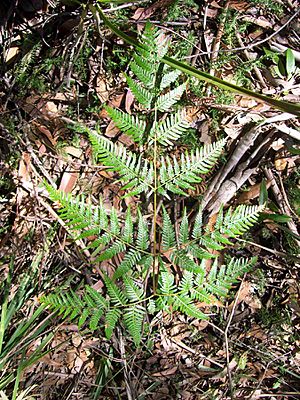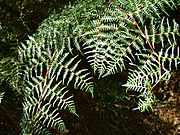Bracken fern facts for kids
Quick facts for kids Bracken fern |
|
|---|---|
 |
|
| Bracken at Chatswood West, Australia | |
| Scientific classification | |
| Genus: |
Pteridium
|
| Species: |
esculentum
|
Pteridium esculentum, often called bracken fern or just bracken, is a type of fern found in many countries in the Southern Hemisphere. Its name, esculentum, means "edible," which tells us something interesting about its past uses.
Contents
About Bracken Fern
Bracken fern was first described by a German botanist named Georg Forster in 1786. This was in 1786. It got its current scientific name in 1908. The Eora people, who are Indigenous Australians from the Sydney area, called this plant gurgi.
What Does Bracken Look Like?
Bracken grows from underground stems called rhizomes. These rhizomes creep along and are covered with reddish hairs. From these underground stems, large, roughly triangular leaves grow. These leaves are called fronds. They can grow quite tall, from about 0.5 to 2 meters (about 1.5 to 6.5 feet) high. The fronds are stiff and have a brown stripe.
Where Does Bracken Grow?
You can find bracken in many places. In Australia, it grows in all states except the Northern Territory. It is also found in New Zealand, Norfolk Island, Malaysia, Polynesia, and New Caledonia.
In Victoria, it is very common, even up to 1000 meters (about 3,300 feet) high. In New South Wales, it grows in the central, eastern, and southern parts of the state. It can also grow easily in areas where the ground has been disturbed. This means it can sometimes take over and become a weed.
Bracken's Role in Nature
Just like its relatives in the Northern Hemisphere, Pteridium esculentum grows very quickly in disturbed areas. It can grow so fast that it outcompetes other plants. This can create a thick layer of bracken under other trees.
Even though it can be seen as a weed, bracken helps create a more humid and sheltered environment under its leaves. It also provides food for many native insects. Scientists have found different types of insects that feed on bracken, including fruit flies and mites.

How People Used Bracken
Historically, people in different parts of the world used bracken as a food source.
Māori Use in New Zealand
The Māori of New Zealand used the rhizomes of bracken, which they called aruhe, as a very important food. It was especially useful for groups who were exploring or hunting away from their homes.
Much of the bracken you see in New Zealand today grew because people cleared forests long ago. They then looked after the bracken stands because the rich soil produced the best rhizomes.
- The rhizomes were dried in the air. This made them lighter and easier to store.
- When it was time to eat them, they were heated briefly.
- Then, they were softened using a special tool called a patu aruhe (rhizome pounder).
- People would then suck the starch from the fibers.
- Sometimes, the starch was collected to prepare for larger feasts.
- Patu aruhe were important tools, and different styles were developed.
Indigenous Australian Use
Aborigines in Australia also ate the roots of bracken. They would pound the roots into a paste. After that, they would roast the paste before eating it.
Important Note on Eating Bracken
While some parts of bracken were eaten in the past, it's important to know that bracken can contain substances that might not be good for you. Because of this, it is generally not recommended to eat bracken today.
Images for kids







